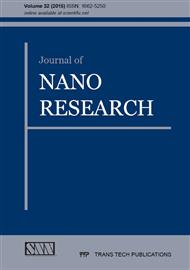p.1
p.17
p.25
p.32
p.43
p.51
p.60
p.66
p.71
Fabrication of Copper Nanowire Arrays by Electrolytic Deposition
Abstract:
Highly ordered copper nanowire arrays were prepared by electrolytic deposition using porous anodic aluminum oxide (AAO) as template. The technique of removing the barrier layer of the AAO template by the pore widening procedure was investigated. The quality of the Au conducting layers sputtered at the bottom side of the AAO template was also studied. The direct current (DC) electrodeposition of copper nanowire arrays was performed efficiently above the Au layer inside the pores. The morphology of the copper nanowires was characterized by scanning electronic microscopy (SEM) and the composition of Cu nanowires was confirmed by energy dispersive X-Ray spectroscopy (EDS). The results showed that the best condition was found to be in phosphoric acid (6%wt) for 10 min to remove the barrier layer completely. Au layer was uniform and dense after sputtering for four times. Copper nanowire arrays were successfully prepared by three-electrode and two-electrode cell electro-deposition, but the nanowire arrays were more ordered by using three-electrode cell and the length of nanowires was more uniform. The diameter of a single Cu nanowire is less than 100 nm with the length up to around 10 μm, and the nanowires are well arranged in arrays.
Info:
Periodical:
Pages:
25-31
Citation:
Online since:
May 2015
Authors:
Keywords:
Price:
Сopyright:
© 2015 Trans Tech Publications Ltd. All Rights Reserved
Share:
Citation:


